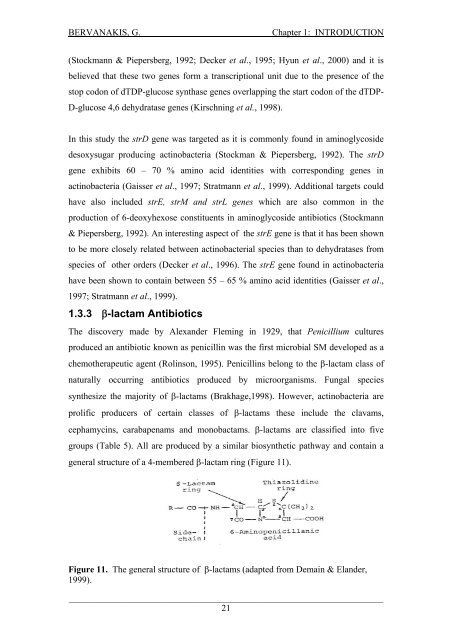Detection and Expression of Biosynthetic Genes in Actinobacteria ...
Detection and Expression of Biosynthetic Genes in Actinobacteria ...
Detection and Expression of Biosynthetic Genes in Actinobacteria ...
You also want an ePaper? Increase the reach of your titles
YUMPU automatically turns print PDFs into web optimized ePapers that Google loves.
BERVANAKIS, G.Chapter 1: INTRODUCTION(Stockmann & Piepersberg, 1992; Decker et al., 1995; Hyun et al., 2000) <strong>and</strong> it isbelieved that these two genes form a transcriptional unit due to the presence <strong>of</strong> thestop codon <strong>of</strong> dTDP-glucose synthase genes overlapp<strong>in</strong>g the start codon <strong>of</strong> the dTDP-D-glucose 4,6 dehydratase genes (Kirschn<strong>in</strong>g et al., 1998).In this study the strD gene was targeted as it is commonly found <strong>in</strong> am<strong>in</strong>oglycosidedesoxysugar produc<strong>in</strong>g act<strong>in</strong>obacteria (Stockman & Piepersberg, 1992). The strDgene exhibits 60 – 70 % am<strong>in</strong>o acid identities with correspond<strong>in</strong>g genes <strong>in</strong>act<strong>in</strong>obacteria (Gaisser et al., 1997; Stratmann et al., 1999). Additional targets couldhave also <strong>in</strong>cluded strE, strM <strong>and</strong> strL genes which are also common <strong>in</strong> theproduction <strong>of</strong> 6-deoxyhexose constituents <strong>in</strong> am<strong>in</strong>oglycoside antibiotics (Stockmann& Piepersberg, 1992). An <strong>in</strong>terest<strong>in</strong>g aspect <strong>of</strong> the strE gene is that it has been shownto be more closely related between act<strong>in</strong>obacterial species than to dehydratases fromspecies <strong>of</strong> other orders (Decker et al., 1996). The strE gene found <strong>in</strong> act<strong>in</strong>obacteriahave been shown to conta<strong>in</strong> between 55 – 65 % am<strong>in</strong>o acid identities (Gaisser et al.,1997; Stratmann et al., 1999).1.3.3 β-lactam AntibioticsThe discovery made by Alex<strong>and</strong>er Flem<strong>in</strong>g <strong>in</strong> 1929, that Penicillium culturesproduced an antibiotic known as penicill<strong>in</strong> was the first microbial SM developed as achemotherapeutic agent (Rol<strong>in</strong>son, 1995). Penicill<strong>in</strong>s belong to the β-lactam class <strong>of</strong>naturally occurr<strong>in</strong>g antibiotics produced by microorganisms. Fungal speciessynthesize the majority <strong>of</strong> β-lactams (Brakhage,1998). However, act<strong>in</strong>obacteria areprolific producers <strong>of</strong> certa<strong>in</strong> classes <strong>of</strong> β-lactams these <strong>in</strong>clude the clavams,cephamyc<strong>in</strong>s, carabapenams <strong>and</strong> monobactams. β-lactams are classified <strong>in</strong>to fivegroups (Table 5). All are produced by a similar biosynthetic pathway <strong>and</strong> conta<strong>in</strong> ageneral structure <strong>of</strong> a 4-membered β-lactam r<strong>in</strong>g (Figure 11).Figure 11. The general structure <strong>of</strong> β-lactams (adapted from Dema<strong>in</strong> & El<strong>and</strong>er,1999)._____________________________________________________________________21















